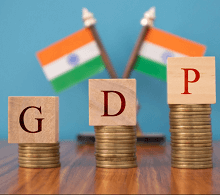GDP - Gross Domestic Product
It refers to the total market or monetary value of all the finished goods and services produced within a country in a specific period such as in one year. The "Gross" means total, "Domestic" means all the economic activities done inside the boundary of the country, "Product" is a word to define goods and services together within the boundaries both by Indians and foreign citizens. GDP only cares about goods produced in the year. The goods produced in one year will be part of GDP even if sold in the next year. GDP measures aggregate spending, aggregate income, and aggregate output. 
Components of GDPThere are four expenditure components. These are as follows:
These components are described below;i) Consumption:Consumption which families are spending for their use. It estimates the cash worth of products that families buy. These are grouped into customer durables, semi-durables, non-durables, and administrations. Broadly, this arrangement of purchaser merchandise depends on the period inside which shopper products are utilized. For example, food, household, medical expenses, rent, Jewellery, gasoline, Private consumption expenditure includes expenditure on all these categories of goods and services. ii) Investment:Investment by business or household in the capital. It includes building machinery, housing construction, buying hardware or gear for the processing plant, buying new houses, and purchasing labor and products. Investment in Financial Products does not include in the investment component of GDP. iii) Government Spending's: This segment sums up government spending on labor and products. It incorporates
All administration buys are an intermediary measure for the government procedure. Such government buys are treated as a component of the eventual outcome. Move instalments made by the government to families and firms are not considered a piece of GDP. Try not to double-check since the utilization or venture by beneficiaries of the exchange instalments is included in C and I. iV) Net Exports: It means Gross exports(X). All goods and services are produced for overseas consumption. It also includes Gross imports (M), which means any goods and services imported for consumption. Types of GDPThere are five types of Gross Domestic Products as described follows: 1) Nominal GDP: It estimates economic output in an economy that includes current prices in its calculation. All goods and services are counted in the nominal GDP which are sold in the current year. It is calculated either in the domestic currency or in U.S. Dollars currency. Nominal GDP is used to compare the different quarter's output within the same year. 2) Real GDP: It measures the number of goods and services produced by an economy in a year. Real GDP is based on the monetary value of goods and services, and it shows inflation. However, this doesn't mirror any adjustment of the amount or nature of labor and products delivered. Nominal GDP is generally higher than Real GDP since expansion is commonly a positive number. Real GDP represents changes in market worth and consequently limits the distinction between yield figures from one year to another. If there is an enormous disparity between a country's Real GDP and ostensible GDP, this might indicate significant inflation or collapse in its economy. 3) Gross domestic product per capita: It is a measure of GDP per capita in a country's population. It indicates that the amount of output or per capita income in an economy can indicate average productivity or average standard of living. GDP per capita can be stated in nominal, real, or purchasing power parity terms. In a basic interpretation, GDP per capita represents how much economic output value can be attributed to each citizen. Per-capita GDP is regularly investigated closely by more conventional proportions of GDP. Financial analysts utilize this measurement for knowledge on their own country's homegrown usefulness and the efficiency of different nations. Per-capita GDP thinks about both a nation's GDP and its populace. Hence, it tends to be critical to see how each factor adds to the general outcome and influences per-capita GDP development. For instance, if a country's per capita GDP is increasing with a constant populace level, it could be a consequence of the latest technology advances producing more with a similar populace level. A few nations may have a high per capita GDP yet a little populace. As a rule, they have developed an independent economy dependent on an abundance of specialized resources. 4) Gross domestic product Growth Rate: The GDP development rate compares the year-over-year (or quarterly) change in a country's monetary yield to gauge how quickly an economy develops. If GDP development rates speed up, it may indicate that the economy is "overheating," and the national bank may raise loan fees. Normally communicated at a rate, this action is mainstream for financial arrangement creators since GDP development is firmly associated with key strategy targets, such as inflation and joblessness rates. On the other hand, national banks see a contracting (negative) GDP development rate (i.e., a downturn) as a sign suggesting bringing rates down and upgrading them if needed. 5) Gross domestic product Purchasing Power Parity: Financial experts see buying power equality (PPP) to perceive how one country's GDP has the goods in "global dollars" utilizing a technique that adapts to contrasts in nearby costs and expenses of living to make cross country correlations of genuine yield, genuine pay, and expectations for everyday comforts. GDP Importance
GDP CalculationThere are two ways for calculating the GDP;
Benefits of GDP1. Universal: It is universal. You can use the GDP of Somalia or the United States of America to check all economies in the world. Whether a nation is producing fishing gear or vehicles, the entirety of its items has specific money-related worth, which gives an all-around perceived measure. This action is particularly helpful if you see how various economies throughout the planet are doing regarding the labor and products they produce and how they reinvest their pay. These variables can be mislabelled. For example, Norway's economy appears smaller than that of the United States. Still, according to the international monetary fund, Norway's 2011 GDP per capita is $96,810, which is almost double that of the U.S. economy. 2. GDP Per Capita: If you partition GDP by the nation's populace, then, at that point, you will get the GDP Per Capita the assessed bit of the nation's absolute yield for every inhabitant, which is a method of contrasting various economies while taking a gander at their capacities, thinking about the size of their labor force and accessible assets. 3. Dynamic: GDP is dynamic since it changes continually dependent on usefulness, utilization, and speculation information. Therefore, economists and decision-maker makers can use this data of GDP to measure the growth and decline of an economy. Nonetheless, they can do as such just if they have set up an exact system to quantify GDP consistently. 5. Focus: Most criticism about GDP is that it focuses on economic data, not on the prosperity of the people. The economic focus of the GDP index is production, consumption, and investment. Hence, it isn't influenced by difficult to-quantify factors like deliberate work and genuine joblessness. Some other benefits of GDP are described below;
Disadvantages of GDP
Some other disadvantages of GDP are described below;
ConclusionGross domestic product represents an amount of a nation's creation, which comprises all acquisition of labor and products delivered by a nation and administrations utilized by an individual, firms, outsiders, and the administering bodies. Higher genuine GDP per capita implies that standard individuals ought to have more major buying power. Without an increment in genuine GDP, there will be continual restrictions to the financial turn of events.
Next TopicNGO - Non-Government Organization
|
 For Videos Join Our Youtube Channel: Join Now
For Videos Join Our Youtube Channel: Join Now
Feedback
- Send your Feedback to [email protected]
Help Others, Please Share










